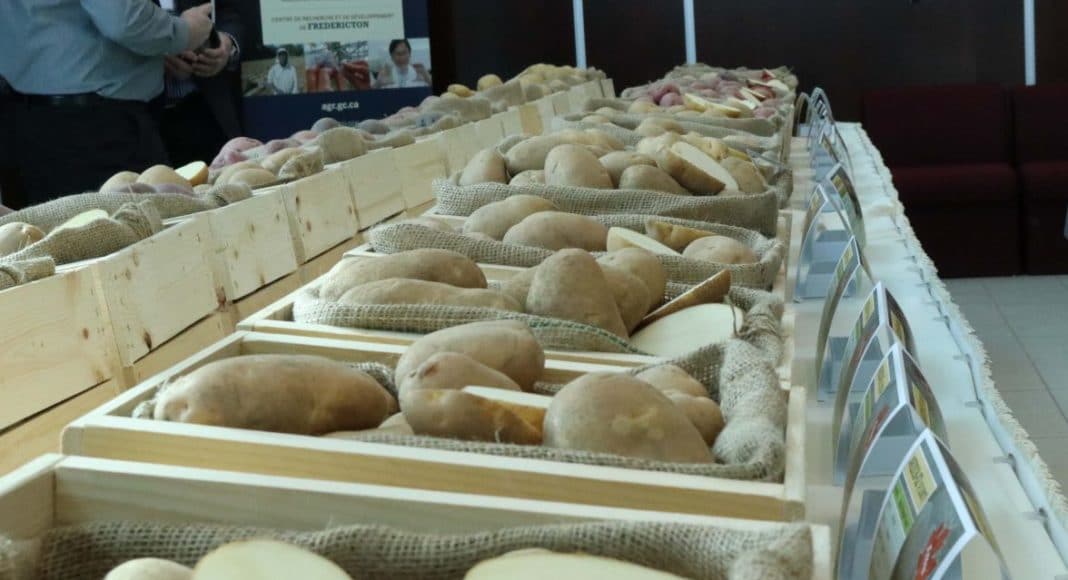[deck]The 2018 AAFC offerings were launched this week, giving the industry many choices.[/deck]
The Agriculture and Agri-Food Canada (AAFC) accelerated release program is a bit like the Olympics of potato variety development. And just like the 2018 Olympic Winter Games, also happening this month, only the very best will make it to the podium.
Out of approximately 100,000 initial AAFC potato seedlings grown in the field six years ago, 15 are being released for industry evaluation this year, and it could take up to three to five years before any of them are deemed golden enough to reach the market.
Potato growers, seed producers and industry members were invited to three simultaneous AAFC open houses in Lethbridge, Alta., Guelph, Ont. and Fredericton, N.B. Presentations on the 15 varieties under consideration were shared by video link and then the varieties could be examined live in each location. For those who missed the event, the presentations can be viewed on the AAFC website.
“The varieties we are offering this year have been in the process of development for six years,” explains Dr. Benoit Bizimungu, AAFC potato breeder and research scientist in Fredericton. He adds the team narrows down the varieties by shape, colour, tuber size, yield potential and other criteria. “In the first year of selection, we look for traits that are more reliable and repeatable, and as the process progresses our criteria become more stringent.”
In the last phase before being chosen for the accelerated release program, the top candidate varieties are placed in adaptation trials across the country. It’s necessary to see how each performs outside Fredericton and Lethbridge.
There is a cross-section of varieties being offered in 2018 including five french fry, two chip, six fresh market and two speciality market. Most of the varieties offer resistance to at least one troublesome pathogen and all produce tubers attractive to their class.
“We think all of this year’s varieties have potential in the marketplace,” Bizimungu says. “In particular, AR2018-2 is a french fry variety that we think is very good.” This oblong selection with russet skin and white flesh has high yield potential and carries a marker with golden nematode resistance.
According to Dr. Lawrence Kawchuk, a pathologist with AAFC in Lethbridge, the team focuses on traits for disease and pest resistance to help growers be more environmentally vigilant. “Late blight resistance has been one of the diseases that excellent progress has been made in identifying and including in the new releases,” he notes.
“We always keep in mind the need to minimize environmental impact,” adds Bizimungu. “We screen for many diseases, including scab resistance, and some of this year’s varieties have PVY and cyst nematode resistance.”
The accelerated release program allows all stakeholders in the potato industry an opportunity to see the top varieties from the AAFC breeding program. The varieties can be signed out under the program and can be evaluated for two years. Participants in the program pay a fee of $100 plus taxes for non-exclusive rights of each variety that interests them, and they can then conduct their own field analysis of the selection for two years.
Following this testing, interested parties can submit cash bids to procure a further three-year period of exclusive testing. If a company or grower continues to be impressed by the variety, an eight-year renewable license can be negotiated to commercialize the selection.
As part of the 2018 open houses, releases from 2016 will be open for exclusive evaluation bids. The process is being embraced by the Canadian industry. In 2017 nearly 100 requests from across the country applied to test the varieties on offer with each offering requested by one or more companies.
“This year we’ve been asked if two of the new varieties can be offered for exclusivity in a bid process,” says Bizimungu. “They will be jump started to an exclusive offering.”
Both varieties are for the fresh market. Potato selection AR2018-11 is round with smooth white skin and cream flesh that has good boil and bake scores and high tuber set. Under the niche market category, Selection AR2018-15 is round with purple skin and flesh with good boil and bake scores and high tuber set that will be of interest for its antioxidant properties.
The open houses not only shine a spotlight on the varieties AAFC breeders believe to be outstanding, but it gives the breeders an opportunity to meet with industry to learn how they can tweak their program to meet future needs.
“This is an opportunity for us as scientists to meet with growers,” says Dr. Jonathan Neilson, the potato health scientist at Lethbridge. “We get to talk to them about issues facing them in the field. As a researcher, I want to get ahead of what is coming and we can’t do that without talking to growers and industry.” He says the open houses allow the breeders to share the science behind each variety, especially since some are the result of what they learned from talking to stakeholders.
The potato industry is expanding in Canada with major investment in processing being made in Alberta. To assist with the growth, AAFC breeders focus on developing varieties to meet the future needs of the processors with attention being paid to the production requirements of growers.
“The improved performance of the emerging advanced lines will help ensure the continued competitiveness and growth of the Canadian potato industry,” says Kawchuk.
Once the 2018 accelerated releases are signed out for further evaluation in the field, the AAFC team will begin work identifying the crosses that show potential to be included in 2019’s offerings.
The list of 15 varieties, with photos, will appear in the spring 2018 issue of Spud Smart.











